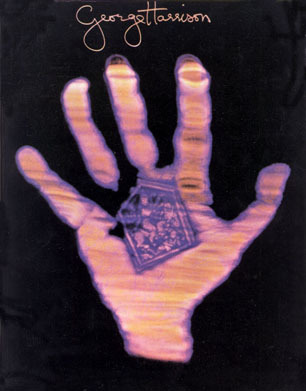
George Harrison - Living In The Material World
There is surely an irony in the fact that, as someone said "George Harrison's misfortune was to be in a group that included John Lennon and Paul McCartney" but on the other hand there is the school of thought that considers Harrison's early post Beatles work to be the the better of all the Beatles solo albums. Perhaps the frustration of only contributing one of two songs to each of the Beatles albums led Harrison to make his first solo album a triple album, encased in a lavish box - "All Things Must Pass" that topped the US chart in early 1971 and included the world-wide number one "My Sweet Lord". Later that year, Harrison organized two benefit concerts at New Yorks Madison Square Garden, in aid of the starving refugees from Bangladesh. An all star cast of artists such as Bob Dylan, Eric Clapton, Ringo Starr, Leon Russell and George's mentor indian classical musician Ravi Shankar (and father of current star Norah Jones) who taught Harrison to play the sitar. Fund raising events like that are commonplace nowadays but in 1971 were virtually unheard of. Recordings from those concerts yielded yet another boxed triple album which won an Album of the Year Grammy Award (and was recently released on DVD).
The lavish presentation of the two lengthy releases might make the single album release of "Living In The Natural world" in 1973 seem somewhat meagre and may have contributed to it being overlooked until now. Recorded at the Apple studios in London, George was joined by a stella group of musicians. His fellow Fab Four member Ringo Starr performing drumming duties along with American session man Jim Keltner. Keyboards handled by Guy Wright and Nicky Hopkins, who at the time was the pianist of choice for the ROlling Stones and The Who amongst many others, sax and flutes provided by Jim Horn and on bass guitar Klaus Voorman who was a friend of the Beatles from their days in The Hamburg Clubs and who drew the famous cover for the classic Revolver album.
The overall feel on most of the tracks is one of calm and spiritually,
especially on the four ballads. "The Day The World Gets Round", "The Light
That Has Lighted The World", "Who Can See It" and "Be Here Now" the title
of which provided Beatles fans Oasis with an album title, and has an Indian
drone in the background. "Who Can See It" is an hymnal sounding ballad
backed by orchestra.
Going against the peaceful mood of most of the album is "Try Some, Buy Some", an anti-heroin song, which George originally wrote for Phil Spector's wife Ronnie and utilizes the Phil Spector produced backing track from that version. Also in acerbic mood is "Sue Me, You Blues", a comment on George's falling out with his fellow Beatles and the legal complications that followed. That track is driven along with funky electric piano reminiscent of the Beatles "Get Back".
Harrison's trademark slide guitar playing is in evidence throughout the album, none more so than the hit single "Give Me Love (Give Me Peace On Earth)". If you wish you can choose the deluxe version of this reissue which has a DVD featuring a concert performance of the aforementioned track and a mini feature of film commissioned in 1973 of the making of the album. On the regular version the two bonus tracks are B Sides of Singles both predominantly acoustic performances "Deep Blue" about the death of his mother, and "Miss O'Dell" in which George for some reason collapses in fits of laughter.
This is a timely reissue of a overlooked and classic album
Derek McCann
*****************
Click
here to leave your George Harrison reviews / comments on the Message Board
(NB: The message board opens in a new window so
please disable your pop-up blocker to view)
*****************